Report: Analyzing Principles of Business Communication and Application
VerifiedAdded on 2020/07/22
|10
|2910
|103
Report
AI Summary
This report comprehensively analyzes the principles of business communication, covering crucial aspects such as negotiation tactics, different types of presentations and their requirements, the creation and presentation of bespoke documents, and the development of information systems. The report details various negotiation approaches, components of negotiation tactics, and the importance of negotiation in the business environment. It further explores different presentation types, resources for presentation development, delivery methods, and best practices, including feedback collection and utilization. The report also examines the characteristics of bespoke documents, factors involved in their creation and presentation, and the legal requirements for gathering information. Lastly, it delves into the typical stages of information system development, its benefits and limitations, legal and security considerations, and methods to assess its effectiveness. The report concludes by summarizing the key findings and providing a complete overview of the subject.
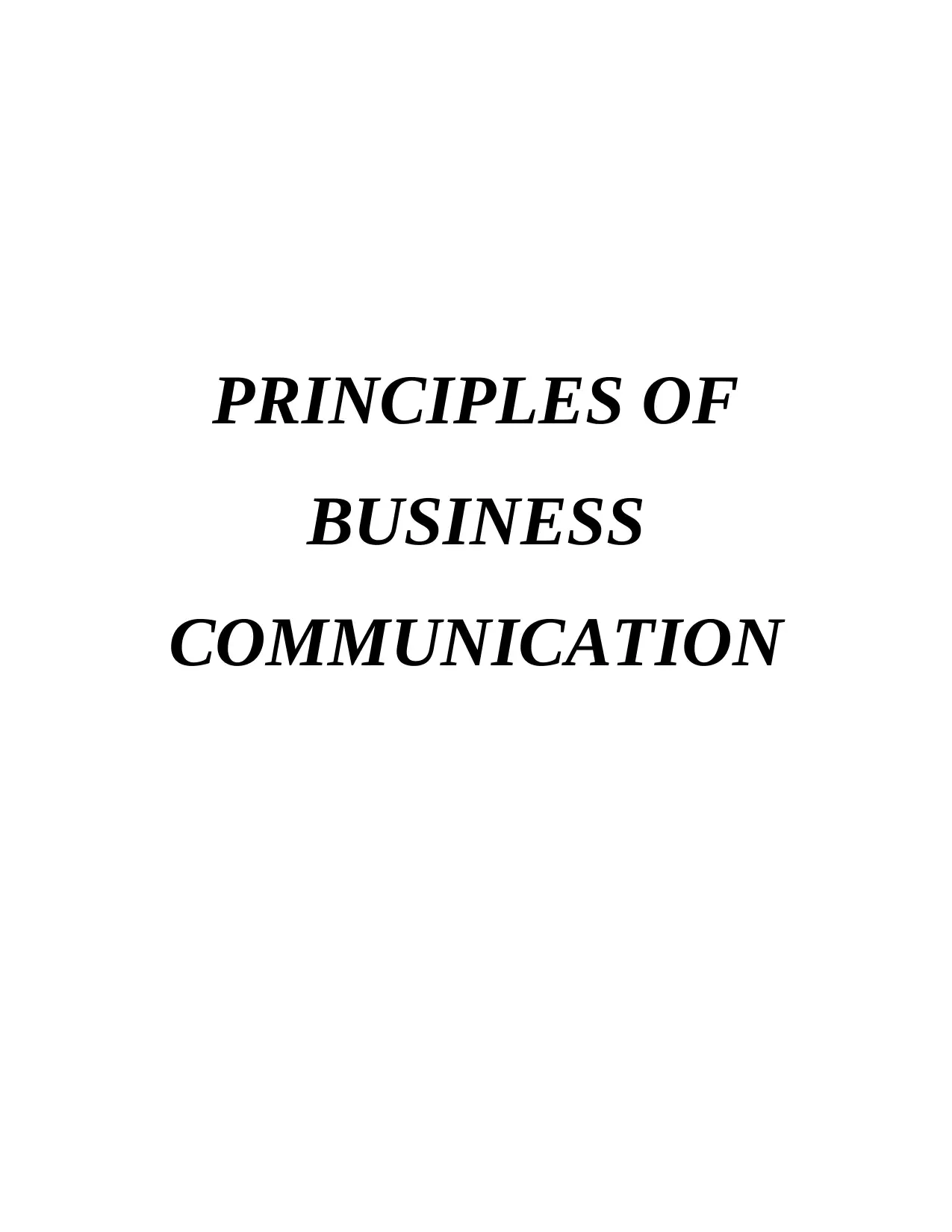
PRINCIPLES OF
BUSINESS
COMMUNICATION
BUSINESS
COMMUNICATION
Paraphrase This Document
Need a fresh take? Get an instant paraphrase of this document with our AI Paraphraser
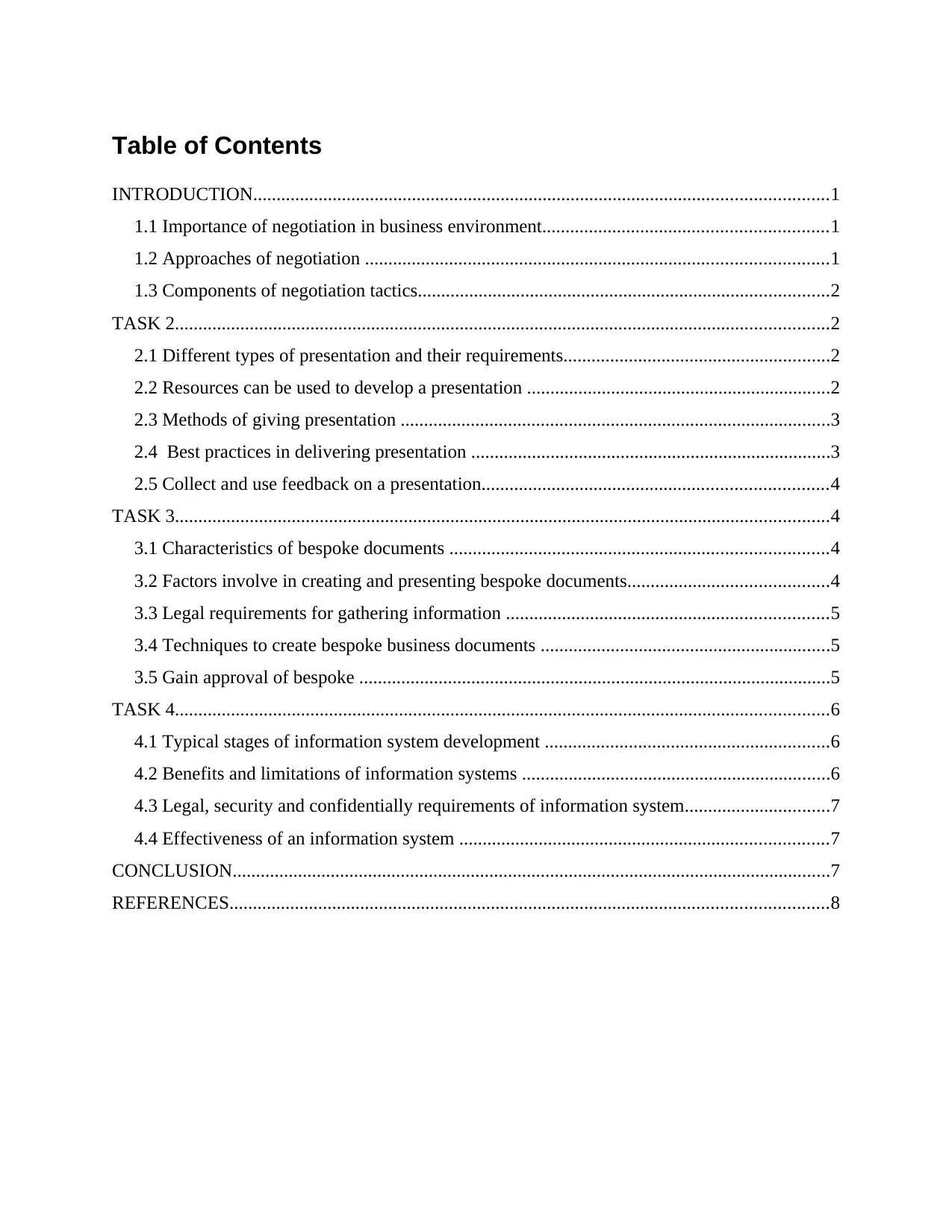
Table of Contents
INTRODUCTION...........................................................................................................................1
1.1 Importance of negotiation in business environment.............................................................1
1.2 Approaches of negotiation ...................................................................................................1
1.3 Components of negotiation tactics........................................................................................2
TASK 2............................................................................................................................................2
2.1 Different types of presentation and their requirements.........................................................2
2.2 Resources can be used to develop a presentation .................................................................2
2.3 Methods of giving presentation ............................................................................................3
2.4 Best practices in delivering presentation .............................................................................3
2.5 Collect and use feedback on a presentation..........................................................................4
TASK 3............................................................................................................................................4
3.1 Characteristics of bespoke documents .................................................................................4
3.2 Factors involve in creating and presenting bespoke documents...........................................4
3.3 Legal requirements for gathering information .....................................................................5
3.4 Techniques to create bespoke business documents ..............................................................5
3.5 Gain approval of bespoke .....................................................................................................5
TASK 4............................................................................................................................................6
4.1 Typical stages of information system development .............................................................6
4.2 Benefits and limitations of information systems ..................................................................6
4.3 Legal, security and confidentially requirements of information system...............................7
4.4 Effectiveness of an information system ...............................................................................7
CONCLUSION................................................................................................................................7
REFERENCES................................................................................................................................8
INTRODUCTION...........................................................................................................................1
1.1 Importance of negotiation in business environment.............................................................1
1.2 Approaches of negotiation ...................................................................................................1
1.3 Components of negotiation tactics........................................................................................2
TASK 2............................................................................................................................................2
2.1 Different types of presentation and their requirements.........................................................2
2.2 Resources can be used to develop a presentation .................................................................2
2.3 Methods of giving presentation ............................................................................................3
2.4 Best practices in delivering presentation .............................................................................3
2.5 Collect and use feedback on a presentation..........................................................................4
TASK 3............................................................................................................................................4
3.1 Characteristics of bespoke documents .................................................................................4
3.2 Factors involve in creating and presenting bespoke documents...........................................4
3.3 Legal requirements for gathering information .....................................................................5
3.4 Techniques to create bespoke business documents ..............................................................5
3.5 Gain approval of bespoke .....................................................................................................5
TASK 4............................................................................................................................................6
4.1 Typical stages of information system development .............................................................6
4.2 Benefits and limitations of information systems ..................................................................6
4.3 Legal, security and confidentially requirements of information system...............................7
4.4 Effectiveness of an information system ...............................................................................7
CONCLUSION................................................................................................................................7
REFERENCES................................................................................................................................8
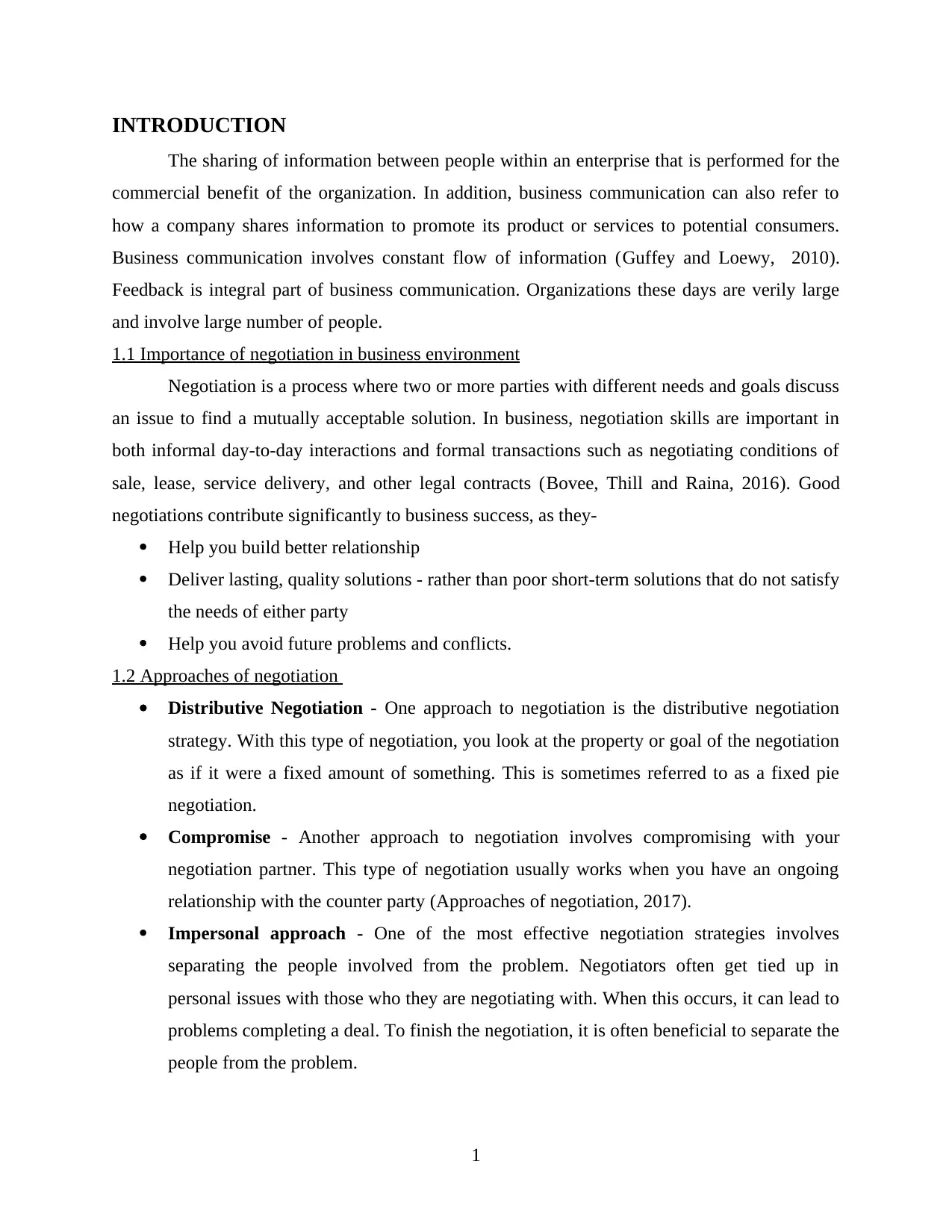
INTRODUCTION
The sharing of information between people within an enterprise that is performed for the
commercial benefit of the organization. In addition, business communication can also refer to
how a company shares information to promote its product or services to potential consumers.
Business communication involves constant flow of information (Guffey and Loewy, 2010).
Feedback is integral part of business communication. Organizations these days are verily large
and involve large number of people.
1.1 Importance of negotiation in business environment
Negotiation is a process where two or more parties with different needs and goals discuss
an issue to find a mutually acceptable solution. In business, negotiation skills are important in
both informal day-to-day interactions and formal transactions such as negotiating conditions of
sale, lease, service delivery, and other legal contracts (Bovee, Thill and Raina, 2016). Good
negotiations contribute significantly to business success, as they-
Help you build better relationship
Deliver lasting, quality solutions - rather than poor short-term solutions that do not satisfy
the needs of either party
Help you avoid future problems and conflicts.
1.2 Approaches of negotiation
Distributive Negotiation - One approach to negotiation is the distributive negotiation
strategy. With this type of negotiation, you look at the property or goal of the negotiation
as if it were a fixed amount of something. This is sometimes referred to as a fixed pie
negotiation.
Compromise - Another approach to negotiation involves compromising with your
negotiation partner. This type of negotiation usually works when you have an ongoing
relationship with the counter party (Approaches of negotiation, 2017).
Impersonal approach - One of the most effective negotiation strategies involves
separating the people involved from the problem. Negotiators often get tied up in
personal issues with those who they are negotiating with. When this occurs, it can lead to
problems completing a deal. To finish the negotiation, it is often beneficial to separate the
people from the problem.
1
The sharing of information between people within an enterprise that is performed for the
commercial benefit of the organization. In addition, business communication can also refer to
how a company shares information to promote its product or services to potential consumers.
Business communication involves constant flow of information (Guffey and Loewy, 2010).
Feedback is integral part of business communication. Organizations these days are verily large
and involve large number of people.
1.1 Importance of negotiation in business environment
Negotiation is a process where two or more parties with different needs and goals discuss
an issue to find a mutually acceptable solution. In business, negotiation skills are important in
both informal day-to-day interactions and formal transactions such as negotiating conditions of
sale, lease, service delivery, and other legal contracts (Bovee, Thill and Raina, 2016). Good
negotiations contribute significantly to business success, as they-
Help you build better relationship
Deliver lasting, quality solutions - rather than poor short-term solutions that do not satisfy
the needs of either party
Help you avoid future problems and conflicts.
1.2 Approaches of negotiation
Distributive Negotiation - One approach to negotiation is the distributive negotiation
strategy. With this type of negotiation, you look at the property or goal of the negotiation
as if it were a fixed amount of something. This is sometimes referred to as a fixed pie
negotiation.
Compromise - Another approach to negotiation involves compromising with your
negotiation partner. This type of negotiation usually works when you have an ongoing
relationship with the counter party (Approaches of negotiation, 2017).
Impersonal approach - One of the most effective negotiation strategies involves
separating the people involved from the problem. Negotiators often get tied up in
personal issues with those who they are negotiating with. When this occurs, it can lead to
problems completing a deal. To finish the negotiation, it is often beneficial to separate the
people from the problem.
1
⊘ This is a preview!⊘
Do you want full access?
Subscribe today to unlock all pages.

Trusted by 1+ million students worldwide
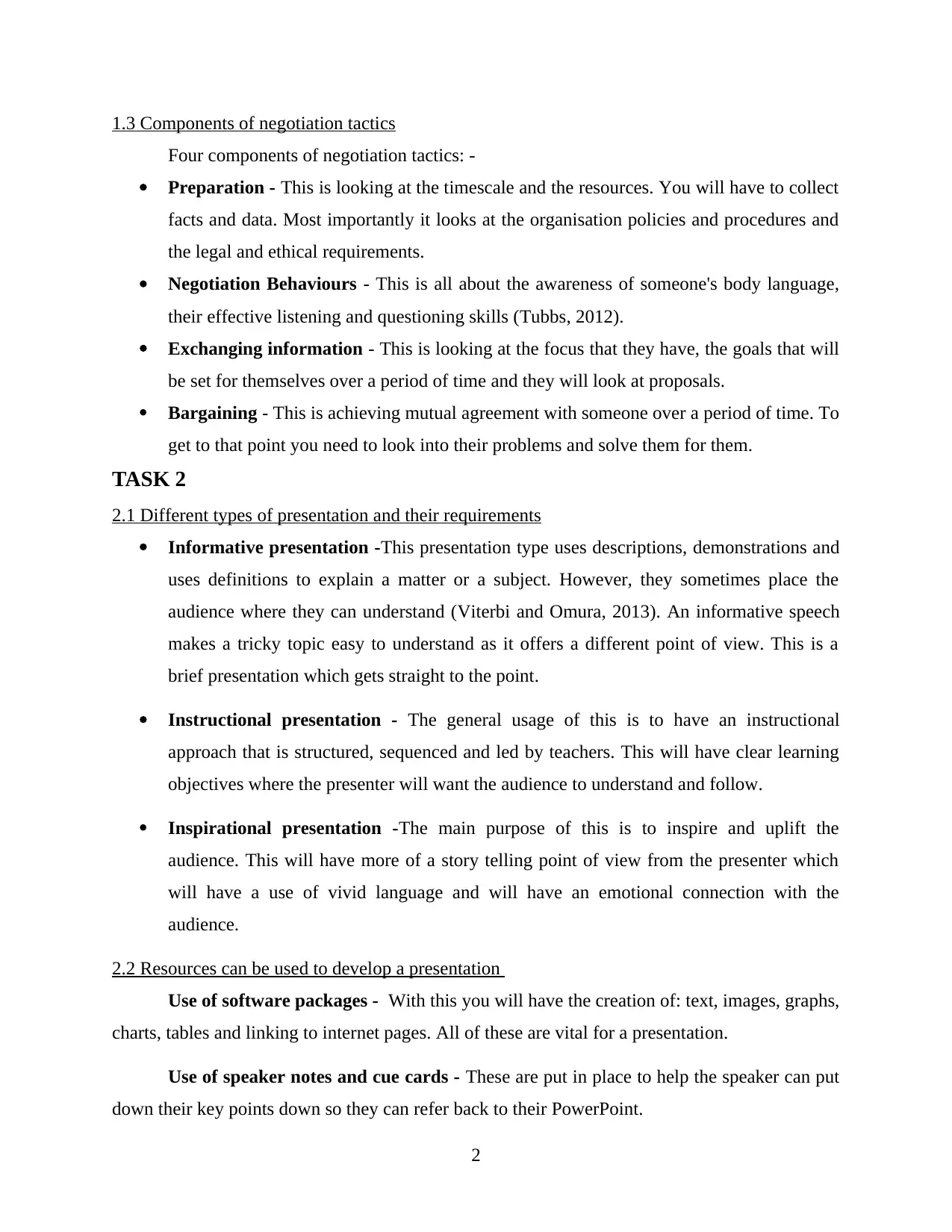
1.3 Components of negotiation tactics
Four components of negotiation tactics: -
Preparation - This is looking at the timescale and the resources. You will have to collect
facts and data. Most importantly it looks at the organisation policies and procedures and
the legal and ethical requirements.
Negotiation Behaviours - This is all about the awareness of someone's body language,
their effective listening and questioning skills (Tubbs, 2012).
Exchanging information - This is looking at the focus that they have, the goals that will
be set for themselves over a period of time and they will look at proposals.
Bargaining - This is achieving mutual agreement with someone over a period of time. To
get to that point you need to look into their problems and solve them for them.
TASK 2
2.1 Different types of presentation and their requirements
Informative presentation -This presentation type uses descriptions, demonstrations and
uses definitions to explain a matter or a subject. However, they sometimes place the
audience where they can understand (Viterbi and Omura, 2013). An informative speech
makes a tricky topic easy to understand as it offers a different point of view. This is a
brief presentation which gets straight to the point.
Instructional presentation - The general usage of this is to have an instructional
approach that is structured, sequenced and led by teachers. This will have clear learning
objectives where the presenter will want the audience to understand and follow.
Inspirational presentation -The main purpose of this is to inspire and uplift the
audience. This will have more of a story telling point of view from the presenter which
will have a use of vivid language and will have an emotional connection with the
audience.
2.2 Resources can be used to develop a presentation
Use of software packages - With this you will have the creation of: text, images, graphs,
charts, tables and linking to internet pages. All of these are vital for a presentation.
Use of speaker notes and cue cards - These are put in place to help the speaker can put
down their key points down so they can refer back to their PowerPoint.
2
Four components of negotiation tactics: -
Preparation - This is looking at the timescale and the resources. You will have to collect
facts and data. Most importantly it looks at the organisation policies and procedures and
the legal and ethical requirements.
Negotiation Behaviours - This is all about the awareness of someone's body language,
their effective listening and questioning skills (Tubbs, 2012).
Exchanging information - This is looking at the focus that they have, the goals that will
be set for themselves over a period of time and they will look at proposals.
Bargaining - This is achieving mutual agreement with someone over a period of time. To
get to that point you need to look into their problems and solve them for them.
TASK 2
2.1 Different types of presentation and their requirements
Informative presentation -This presentation type uses descriptions, demonstrations and
uses definitions to explain a matter or a subject. However, they sometimes place the
audience where they can understand (Viterbi and Omura, 2013). An informative speech
makes a tricky topic easy to understand as it offers a different point of view. This is a
brief presentation which gets straight to the point.
Instructional presentation - The general usage of this is to have an instructional
approach that is structured, sequenced and led by teachers. This will have clear learning
objectives where the presenter will want the audience to understand and follow.
Inspirational presentation -The main purpose of this is to inspire and uplift the
audience. This will have more of a story telling point of view from the presenter which
will have a use of vivid language and will have an emotional connection with the
audience.
2.2 Resources can be used to develop a presentation
Use of software packages - With this you will have the creation of: text, images, graphs,
charts, tables and linking to internet pages. All of these are vital for a presentation.
Use of speaker notes and cue cards - These are put in place to help the speaker can put
down their key points down so they can refer back to their PowerPoint.
2
Paraphrase This Document
Need a fresh take? Get an instant paraphrase of this document with our AI Paraphraser
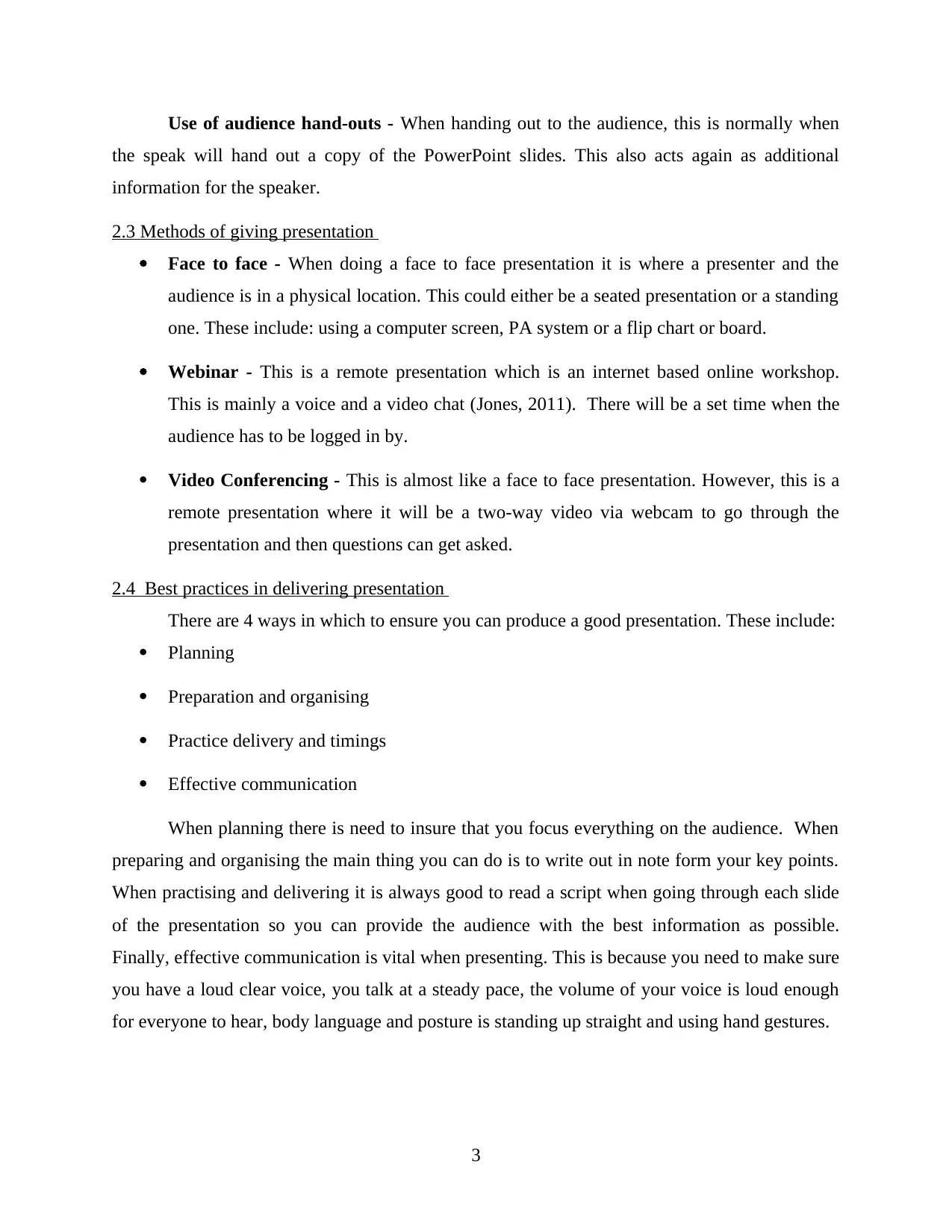
Use of audience hand-outs - When handing out to the audience, this is normally when
the speak will hand out a copy of the PowerPoint slides. This also acts again as additional
information for the speaker.
2.3 Methods of giving presentation
Face to face - When doing a face to face presentation it is where a presenter and the
audience is in a physical location. This could either be a seated presentation or a standing
one. These include: using a computer screen, PA system or a flip chart or board.
Webinar - This is a remote presentation which is an internet based online workshop.
This is mainly a voice and a video chat (Jones, 2011). There will be a set time when the
audience has to be logged in by.
Video Conferencing - This is almost like a face to face presentation. However, this is a
remote presentation where it will be a two-way video via webcam to go through the
presentation and then questions can get asked.
2.4 Best practices in delivering presentation
There are 4 ways in which to ensure you can produce a good presentation. These include:
Planning
Preparation and organising
Practice delivery and timings
Effective communication
When planning there is need to insure that you focus everything on the audience. When
preparing and organising the main thing you can do is to write out in note form your key points.
When practising and delivering it is always good to read a script when going through each slide
of the presentation so you can provide the audience with the best information as possible.
Finally, effective communication is vital when presenting. This is because you need to make sure
you have a loud clear voice, you talk at a steady pace, the volume of your voice is loud enough
for everyone to hear, body language and posture is standing up straight and using hand gestures.
3
the speak will hand out a copy of the PowerPoint slides. This also acts again as additional
information for the speaker.
2.3 Methods of giving presentation
Face to face - When doing a face to face presentation it is where a presenter and the
audience is in a physical location. This could either be a seated presentation or a standing
one. These include: using a computer screen, PA system or a flip chart or board.
Webinar - This is a remote presentation which is an internet based online workshop.
This is mainly a voice and a video chat (Jones, 2011). There will be a set time when the
audience has to be logged in by.
Video Conferencing - This is almost like a face to face presentation. However, this is a
remote presentation where it will be a two-way video via webcam to go through the
presentation and then questions can get asked.
2.4 Best practices in delivering presentation
There are 4 ways in which to ensure you can produce a good presentation. These include:
Planning
Preparation and organising
Practice delivery and timings
Effective communication
When planning there is need to insure that you focus everything on the audience. When
preparing and organising the main thing you can do is to write out in note form your key points.
When practising and delivering it is always good to read a script when going through each slide
of the presentation so you can provide the audience with the best information as possible.
Finally, effective communication is vital when presenting. This is because you need to make sure
you have a loud clear voice, you talk at a steady pace, the volume of your voice is loud enough
for everyone to hear, body language and posture is standing up straight and using hand gestures.
3
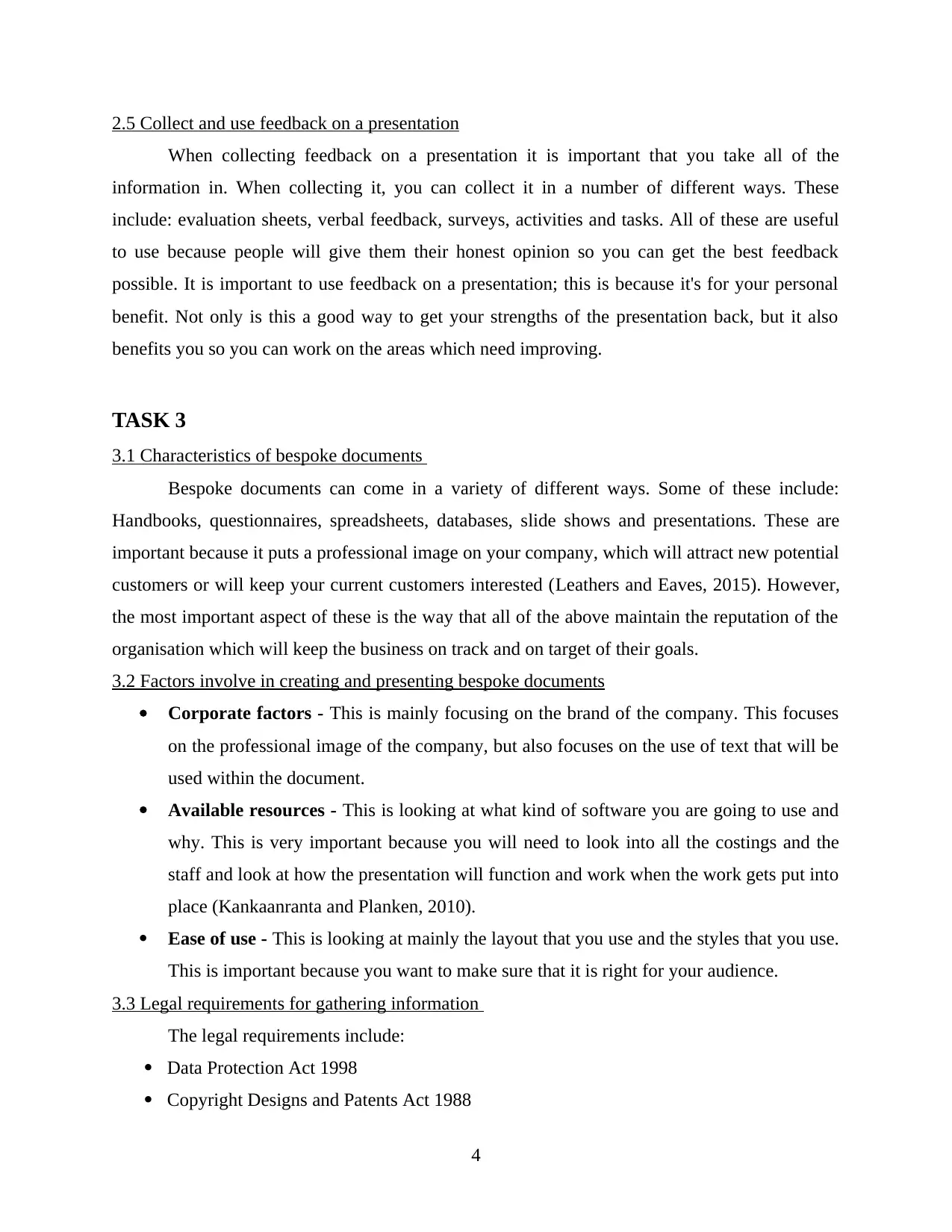
2.5 Collect and use feedback on a presentation
When collecting feedback on a presentation it is important that you take all of the
information in. When collecting it, you can collect it in a number of different ways. These
include: evaluation sheets, verbal feedback, surveys, activities and tasks. All of these are useful
to use because people will give them their honest opinion so you can get the best feedback
possible. It is important to use feedback on a presentation; this is because it's for your personal
benefit. Not only is this a good way to get your strengths of the presentation back, but it also
benefits you so you can work on the areas which need improving.
TASK 3
3.1 Characteristics of bespoke documents
Bespoke documents can come in a variety of different ways. Some of these include:
Handbooks, questionnaires, spreadsheets, databases, slide shows and presentations. These are
important because it puts a professional image on your company, which will attract new potential
customers or will keep your current customers interested (Leathers and Eaves, 2015). However,
the most important aspect of these is the way that all of the above maintain the reputation of the
organisation which will keep the business on track and on target of their goals.
3.2 Factors involve in creating and presenting bespoke documents
Corporate factors - This is mainly focusing on the brand of the company. This focuses
on the professional image of the company, but also focuses on the use of text that will be
used within the document.
Available resources - This is looking at what kind of software you are going to use and
why. This is very important because you will need to look into all the costings and the
staff and look at how the presentation will function and work when the work gets put into
place (Kankaanranta and Planken, 2010).
Ease of use - This is looking at mainly the layout that you use and the styles that you use.
This is important because you want to make sure that it is right for your audience.
3.3 Legal requirements for gathering information
The legal requirements include:
Data Protection Act 1998
Copyright Designs and Patents Act 1988
4
When collecting feedback on a presentation it is important that you take all of the
information in. When collecting it, you can collect it in a number of different ways. These
include: evaluation sheets, verbal feedback, surveys, activities and tasks. All of these are useful
to use because people will give them their honest opinion so you can get the best feedback
possible. It is important to use feedback on a presentation; this is because it's for your personal
benefit. Not only is this a good way to get your strengths of the presentation back, but it also
benefits you so you can work on the areas which need improving.
TASK 3
3.1 Characteristics of bespoke documents
Bespoke documents can come in a variety of different ways. Some of these include:
Handbooks, questionnaires, spreadsheets, databases, slide shows and presentations. These are
important because it puts a professional image on your company, which will attract new potential
customers or will keep your current customers interested (Leathers and Eaves, 2015). However,
the most important aspect of these is the way that all of the above maintain the reputation of the
organisation which will keep the business on track and on target of their goals.
3.2 Factors involve in creating and presenting bespoke documents
Corporate factors - This is mainly focusing on the brand of the company. This focuses
on the professional image of the company, but also focuses on the use of text that will be
used within the document.
Available resources - This is looking at what kind of software you are going to use and
why. This is very important because you will need to look into all the costings and the
staff and look at how the presentation will function and work when the work gets put into
place (Kankaanranta and Planken, 2010).
Ease of use - This is looking at mainly the layout that you use and the styles that you use.
This is important because you want to make sure that it is right for your audience.
3.3 Legal requirements for gathering information
The legal requirements include:
Data Protection Act 1998
Copyright Designs and Patents Act 1988
4
⊘ This is a preview!⊘
Do you want full access?
Subscribe today to unlock all pages.

Trusted by 1+ million students worldwide
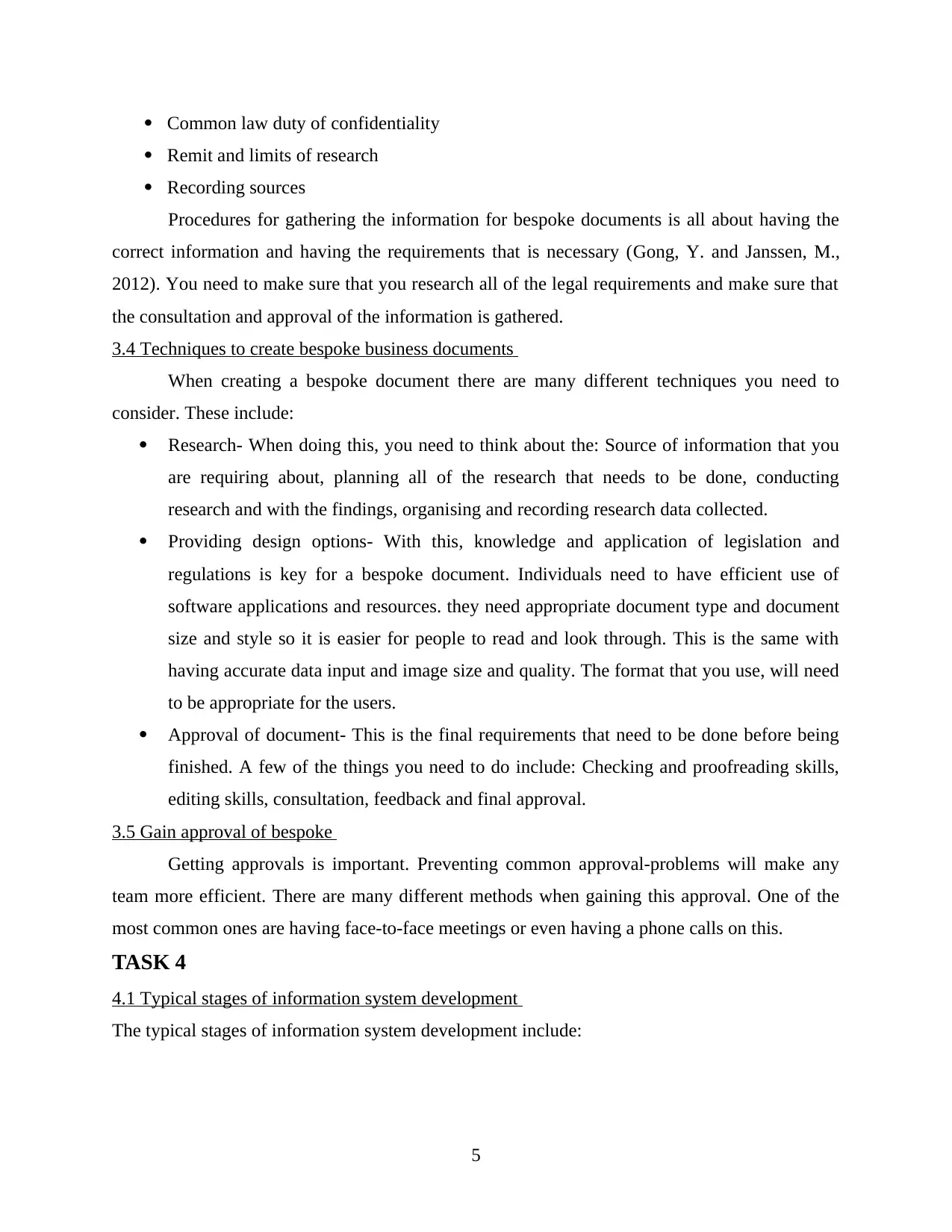
Common law duty of confidentiality
Remit and limits of research
Recording sources
Procedures for gathering the information for bespoke documents is all about having the
correct information and having the requirements that is necessary (Gong, Y. and Janssen, M.,
2012). You need to make sure that you research all of the legal requirements and make sure that
the consultation and approval of the information is gathered.
3.4 Techniques to create bespoke business documents
When creating a bespoke document there are many different techniques you need to
consider. These include:
Research- When doing this, you need to think about the: Source of information that you
are requiring about, planning all of the research that needs to be done, conducting
research and with the findings, organising and recording research data collected.
Providing design options- With this, knowledge and application of legislation and
regulations is key for a bespoke document. Individuals need to have efficient use of
software applications and resources. they need appropriate document type and document
size and style so it is easier for people to read and look through. This is the same with
having accurate data input and image size and quality. The format that you use, will need
to be appropriate for the users.
Approval of document- This is the final requirements that need to be done before being
finished. A few of the things you need to do include: Checking and proofreading skills,
editing skills, consultation, feedback and final approval.
3.5 Gain approval of bespoke
Getting approvals is important. Preventing common approval-problems will make any
team more efficient. There are many different methods when gaining this approval. One of the
most common ones are having face-to-face meetings or even having a phone calls on this.
TASK 4
4.1 Typical stages of information system development
The typical stages of information system development include:
5
Remit and limits of research
Recording sources
Procedures for gathering the information for bespoke documents is all about having the
correct information and having the requirements that is necessary (Gong, Y. and Janssen, M.,
2012). You need to make sure that you research all of the legal requirements and make sure that
the consultation and approval of the information is gathered.
3.4 Techniques to create bespoke business documents
When creating a bespoke document there are many different techniques you need to
consider. These include:
Research- When doing this, you need to think about the: Source of information that you
are requiring about, planning all of the research that needs to be done, conducting
research and with the findings, organising and recording research data collected.
Providing design options- With this, knowledge and application of legislation and
regulations is key for a bespoke document. Individuals need to have efficient use of
software applications and resources. they need appropriate document type and document
size and style so it is easier for people to read and look through. This is the same with
having accurate data input and image size and quality. The format that you use, will need
to be appropriate for the users.
Approval of document- This is the final requirements that need to be done before being
finished. A few of the things you need to do include: Checking and proofreading skills,
editing skills, consultation, feedback and final approval.
3.5 Gain approval of bespoke
Getting approvals is important. Preventing common approval-problems will make any
team more efficient. There are many different methods when gaining this approval. One of the
most common ones are having face-to-face meetings or even having a phone calls on this.
TASK 4
4.1 Typical stages of information system development
The typical stages of information system development include:
5
Paraphrase This Document
Need a fresh take? Get an instant paraphrase of this document with our AI Paraphraser
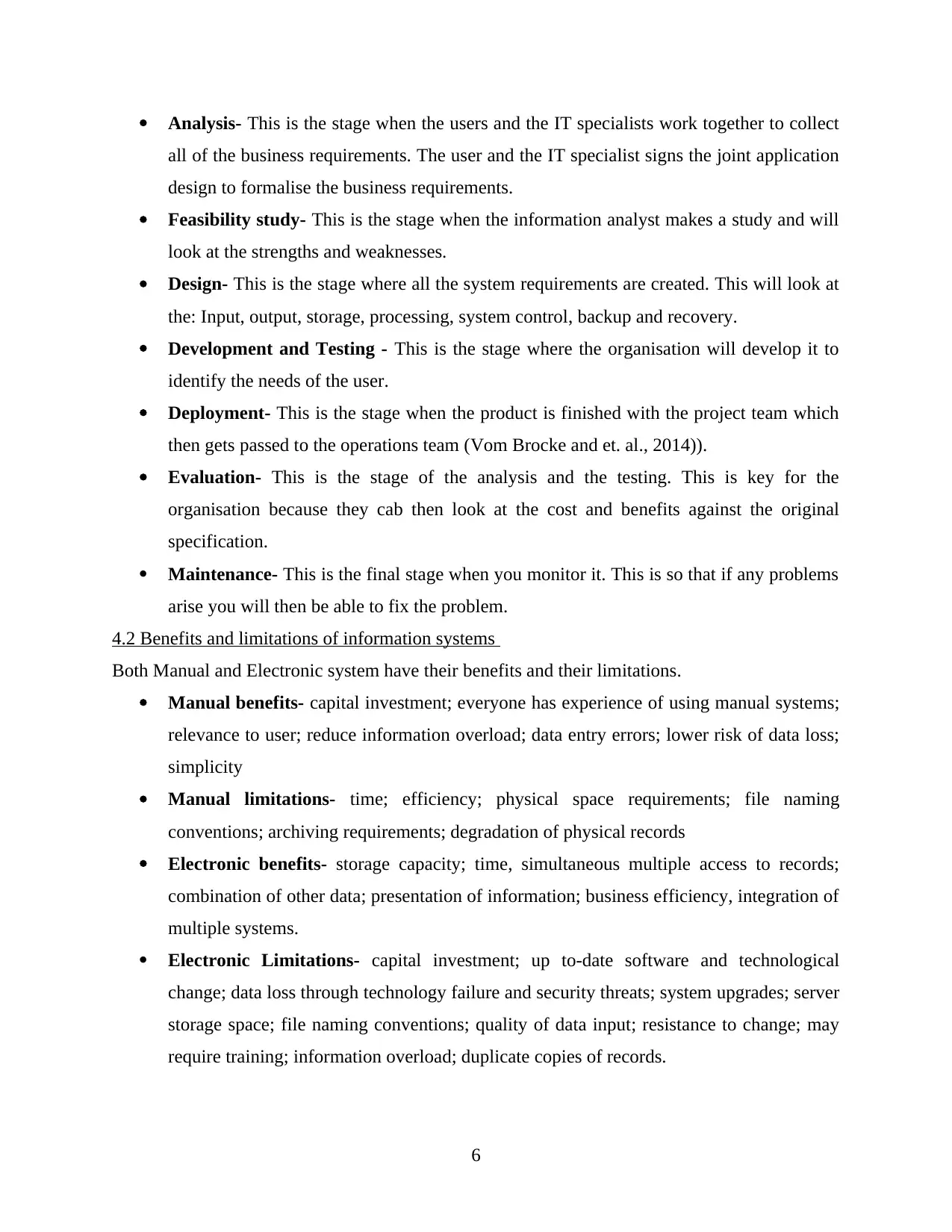
Analysis- This is the stage when the users and the IT specialists work together to collect
all of the business requirements. The user and the IT specialist signs the joint application
design to formalise the business requirements.
Feasibility study- This is the stage when the information analyst makes a study and will
look at the strengths and weaknesses.
Design- This is the stage where all the system requirements are created. This will look at
the: Input, output, storage, processing, system control, backup and recovery.
Development and Testing - This is the stage where the organisation will develop it to
identify the needs of the user.
Deployment- This is the stage when the product is finished with the project team which
then gets passed to the operations team (Vom Brocke and et. al., 2014)).
Evaluation- This is the stage of the analysis and the testing. This is key for the
organisation because they cab then look at the cost and benefits against the original
specification.
Maintenance- This is the final stage when you monitor it. This is so that if any problems
arise you will then be able to fix the problem.
4.2 Benefits and limitations of information systems
Both Manual and Electronic system have their benefits and their limitations.
Manual benefits- capital investment; everyone has experience of using manual systems;
relevance to user; reduce information overload; data entry errors; lower risk of data loss;
simplicity
Manual limitations- time; efficiency; physical space requirements; file naming
conventions; archiving requirements; degradation of physical records
Electronic benefits- storage capacity; time, simultaneous multiple access to records;
combination of other data; presentation of information; business efficiency, integration of
multiple systems.
Electronic Limitations- capital investment; up to-date software and technological
change; data loss through technology failure and security threats; system upgrades; server
storage space; file naming conventions; quality of data input; resistance to change; may
require training; information overload; duplicate copies of records.
6
all of the business requirements. The user and the IT specialist signs the joint application
design to formalise the business requirements.
Feasibility study- This is the stage when the information analyst makes a study and will
look at the strengths and weaknesses.
Design- This is the stage where all the system requirements are created. This will look at
the: Input, output, storage, processing, system control, backup and recovery.
Development and Testing - This is the stage where the organisation will develop it to
identify the needs of the user.
Deployment- This is the stage when the product is finished with the project team which
then gets passed to the operations team (Vom Brocke and et. al., 2014)).
Evaluation- This is the stage of the analysis and the testing. This is key for the
organisation because they cab then look at the cost and benefits against the original
specification.
Maintenance- This is the final stage when you monitor it. This is so that if any problems
arise you will then be able to fix the problem.
4.2 Benefits and limitations of information systems
Both Manual and Electronic system have their benefits and their limitations.
Manual benefits- capital investment; everyone has experience of using manual systems;
relevance to user; reduce information overload; data entry errors; lower risk of data loss;
simplicity
Manual limitations- time; efficiency; physical space requirements; file naming
conventions; archiving requirements; degradation of physical records
Electronic benefits- storage capacity; time, simultaneous multiple access to records;
combination of other data; presentation of information; business efficiency, integration of
multiple systems.
Electronic Limitations- capital investment; up to-date software and technological
change; data loss through technology failure and security threats; system upgrades; server
storage space; file naming conventions; quality of data input; resistance to change; may
require training; information overload; duplicate copies of records.
6
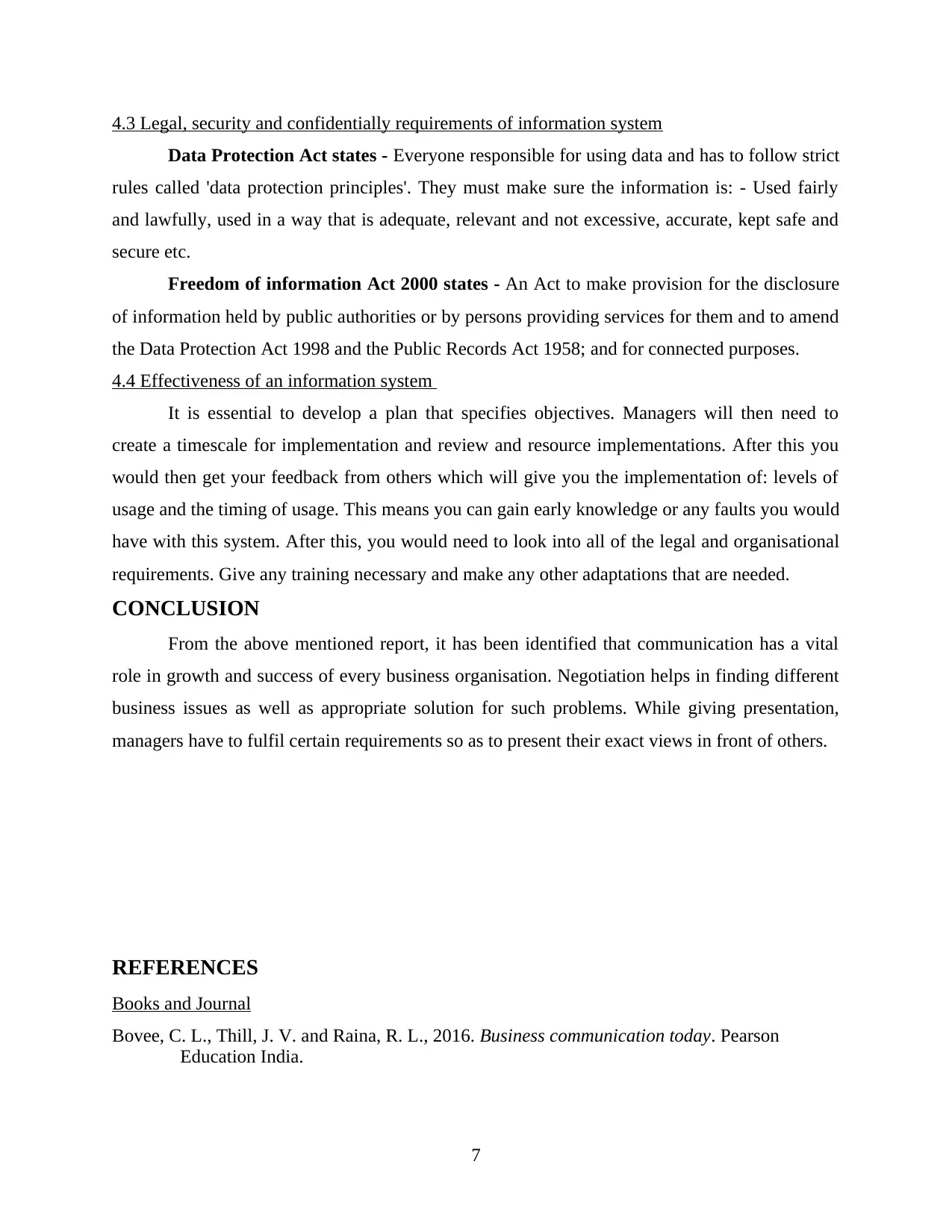
4.3 Legal, security and confidentially requirements of information system
Data Protection Act states - Everyone responsible for using data and has to follow strict
rules called 'data protection principles'. They must make sure the information is: - Used fairly
and lawfully, used in a way that is adequate, relevant and not excessive, accurate, kept safe and
secure etc.
Freedom of information Act 2000 states - An Act to make provision for the disclosure
of information held by public authorities or by persons providing services for them and to amend
the Data Protection Act 1998 and the Public Records Act 1958; and for connected purposes.
4.4 Effectiveness of an information system
It is essential to develop a plan that specifies objectives. Managers will then need to
create a timescale for implementation and review and resource implementations. After this you
would then get your feedback from others which will give you the implementation of: levels of
usage and the timing of usage. This means you can gain early knowledge or any faults you would
have with this system. After this, you would need to look into all of the legal and organisational
requirements. Give any training necessary and make any other adaptations that are needed.
CONCLUSION
From the above mentioned report, it has been identified that communication has a vital
role in growth and success of every business organisation. Negotiation helps in finding different
business issues as well as appropriate solution for such problems. While giving presentation,
managers have to fulfil certain requirements so as to present their exact views in front of others.
REFERENCES
Books and Journal
Bovee, C. L., Thill, J. V. and Raina, R. L., 2016. Business communication today. Pearson
Education India.
7
Data Protection Act states - Everyone responsible for using data and has to follow strict
rules called 'data protection principles'. They must make sure the information is: - Used fairly
and lawfully, used in a way that is adequate, relevant and not excessive, accurate, kept safe and
secure etc.
Freedom of information Act 2000 states - An Act to make provision for the disclosure
of information held by public authorities or by persons providing services for them and to amend
the Data Protection Act 1998 and the Public Records Act 1958; and for connected purposes.
4.4 Effectiveness of an information system
It is essential to develop a plan that specifies objectives. Managers will then need to
create a timescale for implementation and review and resource implementations. After this you
would then get your feedback from others which will give you the implementation of: levels of
usage and the timing of usage. This means you can gain early knowledge or any faults you would
have with this system. After this, you would need to look into all of the legal and organisational
requirements. Give any training necessary and make any other adaptations that are needed.
CONCLUSION
From the above mentioned report, it has been identified that communication has a vital
role in growth and success of every business organisation. Negotiation helps in finding different
business issues as well as appropriate solution for such problems. While giving presentation,
managers have to fulfil certain requirements so as to present their exact views in front of others.
REFERENCES
Books and Journal
Bovee, C. L., Thill, J. V. and Raina, R. L., 2016. Business communication today. Pearson
Education India.
7
⊘ This is a preview!⊘
Do you want full access?
Subscribe today to unlock all pages.

Trusted by 1+ million students worldwide
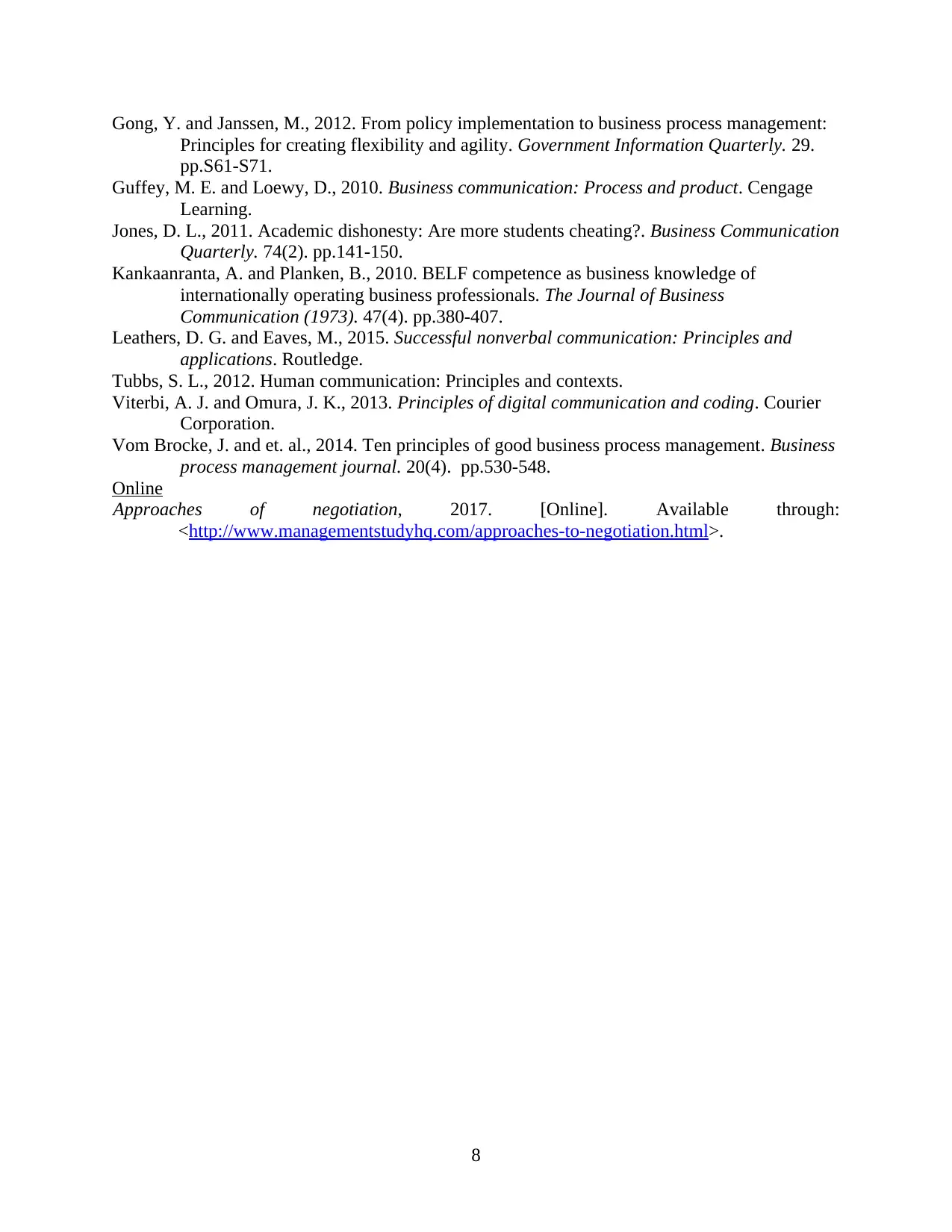
Gong, Y. and Janssen, M., 2012. From policy implementation to business process management:
Principles for creating flexibility and agility. Government Information Quarterly. 29.
pp.S61-S71.
Guffey, M. E. and Loewy, D., 2010. Business communication: Process and product. Cengage
Learning.
Jones, D. L., 2011. Academic dishonesty: Are more students cheating?. Business Communication
Quarterly. 74(2). pp.141-150.
Kankaanranta, A. and Planken, B., 2010. BELF competence as business knowledge of
internationally operating business professionals. The Journal of Business
Communication (1973). 47(4). pp.380-407.
Leathers, D. G. and Eaves, M., 2015. Successful nonverbal communication: Principles and
applications. Routledge.
Tubbs, S. L., 2012. Human communication: Principles and contexts.
Viterbi, A. J. and Omura, J. K., 2013. Principles of digital communication and coding. Courier
Corporation.
Vom Brocke, J. and et. al., 2014. Ten principles of good business process management. Business
process management journal. 20(4). pp.530-548.
Online
Approaches of negotiation, 2017. [Online]. Available through:
<http://www.managementstudyhq.com/approaches-to-negotiation.html>.
8
Principles for creating flexibility and agility. Government Information Quarterly. 29.
pp.S61-S71.
Guffey, M. E. and Loewy, D., 2010. Business communication: Process and product. Cengage
Learning.
Jones, D. L., 2011. Academic dishonesty: Are more students cheating?. Business Communication
Quarterly. 74(2). pp.141-150.
Kankaanranta, A. and Planken, B., 2010. BELF competence as business knowledge of
internationally operating business professionals. The Journal of Business
Communication (1973). 47(4). pp.380-407.
Leathers, D. G. and Eaves, M., 2015. Successful nonverbal communication: Principles and
applications. Routledge.
Tubbs, S. L., 2012. Human communication: Principles and contexts.
Viterbi, A. J. and Omura, J. K., 2013. Principles of digital communication and coding. Courier
Corporation.
Vom Brocke, J. and et. al., 2014. Ten principles of good business process management. Business
process management journal. 20(4). pp.530-548.
Online
Approaches of negotiation, 2017. [Online]. Available through:
<http://www.managementstudyhq.com/approaches-to-negotiation.html>.
8
1 out of 10
Related Documents
Your All-in-One AI-Powered Toolkit for Academic Success.
+13062052269
info@desklib.com
Available 24*7 on WhatsApp / Email
![[object Object]](/_next/static/media/star-bottom.7253800d.svg)
Unlock your academic potential
Copyright © 2020–2025 A2Z Services. All Rights Reserved. Developed and managed by ZUCOL.





